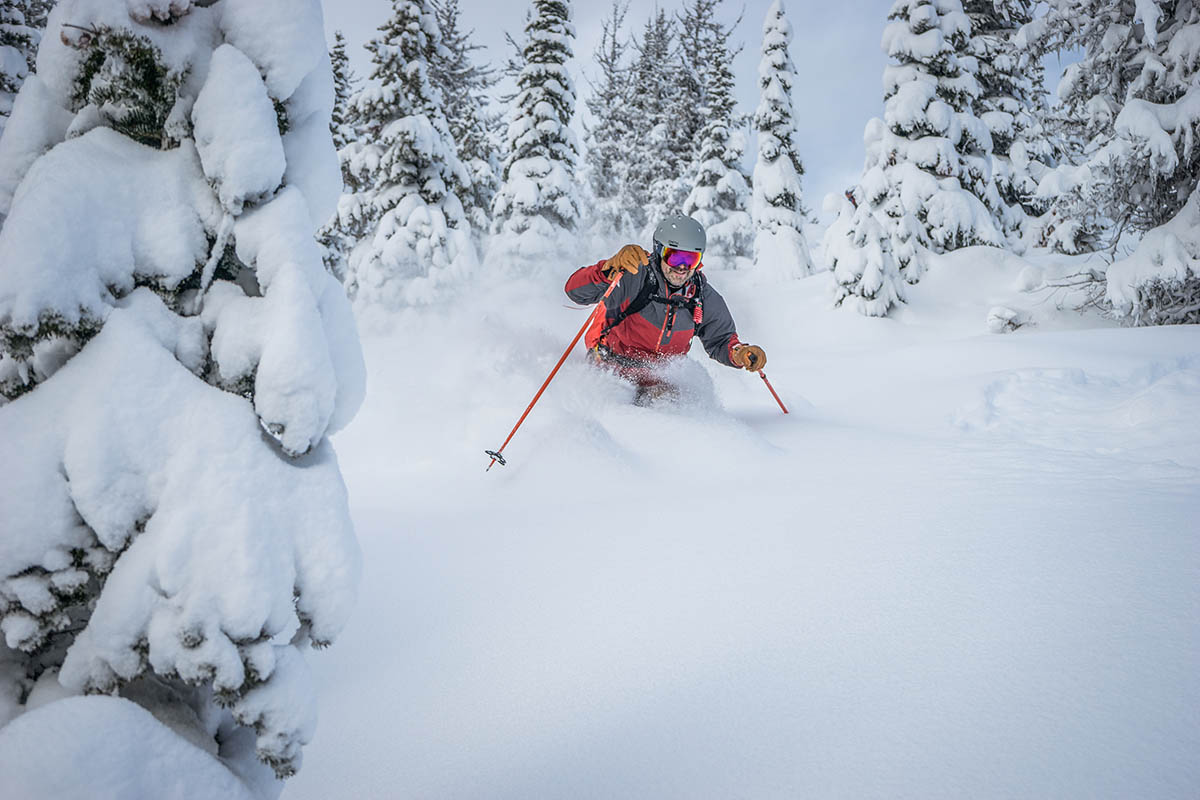
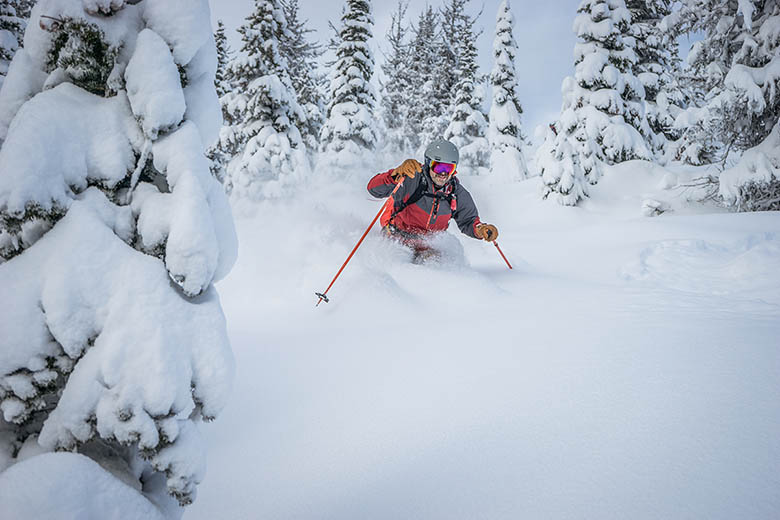
Whether you’re an intermediate skier making the transition from resort to backcountry or a seasoned rider who lives for secret stashes and untracked terrain, a dedicated powder ski can make a world of difference in deep snow. Compared to traditional resort and all-mountain designs, powder-focused models are much wider underfoot (typically around 110-120mm) for maximizing float off-piste. From fast and powerful options for hard chargers to light and playful planks with great surfability, we’ve compiled a list of our favorite powder skis of winter 2024-2025 below. For more background information and help with choosing the best option for you, see our comparison table and buying advice below the picks.
Editor’s note: We updated this guide on October 22, 2024, to remove a few discontinued skis and update several others to the latest 2024-2025 versions. We also included details about our testing practices below the picks and swept the guide to ensure all information was current at the time of publishing.
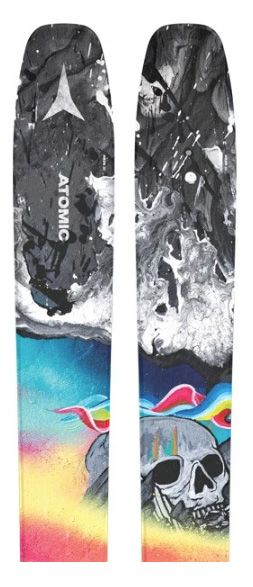 Ability level: Advanced to expert
Ability level: Advanced to expert
Dimensions: 143-120-134mm (184cm)
Lengths: 176, 184, 192cm
What we like: Exceptionally powerful for the weight.
What we don’t: Too much ski for areas that only see moderate snowfall.
The hallmark of professional skier and artist, Chris Benchetler, Atomic’s Bent Chetler 120 is one of the most decorated designs on the market and a legend in the world of powder skiing. Atomic has tweaked the design since its original debut in 2008, but the award-winning combination of playfulness and hard-charging capabilities remains. Poplar wood in the core combined with a carbon insert through the length of the ski strikes a nice balance between weight and power, resulting in a ski that’s light enough to surf, float, and take flight with enough strength to stomp the landing and hold an edge at speed. Updated for 2024-2025 with a new topsheet, the latest “Bent Chetty” is eye-catching and sure to be a crowd pleaser this coming season.
Light and poppy for its size, the Atomic Bent Chetler 120 is a worthwhile crossover ski for the resort and/or the backcountry. Note, however, that it’s an unapologetically hard-charging design that shouldn't be the only ski in your quiver. Additionally, since this big plank loves to go fast, it’s too much ski for beginners and timid intermediate riders, and the 120-millimeter waist will be overkill for regions that aren’t true deep-powder destinations (though Atomic offers other widths, including the Bent 110). Finally, although the Atomic is available in three lengths (176, 184, and 192cm), the shortest option may still be too large for even the most confident of short-statured skiers. But if the sizing works for you, the Bent Chetler is an undeniably capable ski and one of the most well-rounded designs on the market, earning it our top spot for the 2024-2025 season.
See the Atomic Bent Chetler 120
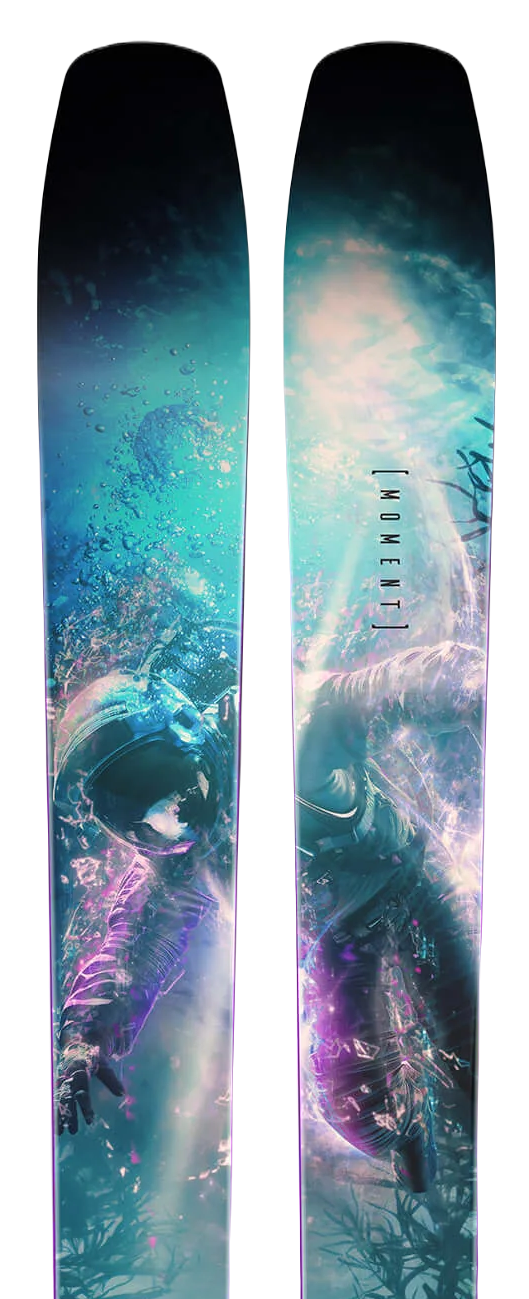 Ability level: Advanced to expert
Ability level: Advanced to expert
Dimensions: 141-116-131mm (179cm)
Lengths: 164, 174, 179, 184, 190, 196cm
What we like: A ski that loves to go fast and maintains its stability at speed.
What we don’t: Sturdy feel sacrifices some float; heavy.
For powder hounds addicted to sniffing out secret stashes and untracked chutes, the Moment Wildcat is sure to stoke your inner prey drive. A ski that loves to play, the Wildcat offers excellent top-end stability while navigating chopped-up snow in the runout or unexpected crud in the trees. Constructed with a lively poplar/ash core and functional blend of fiberglass and carbon fiber, this ski is built to go fast with enough rigidity to maintain composure at high speeds. We also like the mustache rocker profile, which curves up at the tip and tail with camber underfoot for quickly maneuvering through trees and other tight spaces. The net result is a playful, versatile ski that should make even the hardest-charging riders happy.
All that said, the Wildcat’s sturdy feel does come with some compromises, the biggest of which is float (or lack thereof). While the rockered shape and relatively generous dimensions keep the Wildcat firmly in the powder category, it’s less deep-day-ready than designs like the Faction La Machine 5, DPS Carbon Lotus 124, and 4Frnt Renegade below. However, if you like to go fast and don’t mind sacrificing a little surface area for better top-end stability, then the Moment Wildcat should be on your short list.
See the Moment Wildcat
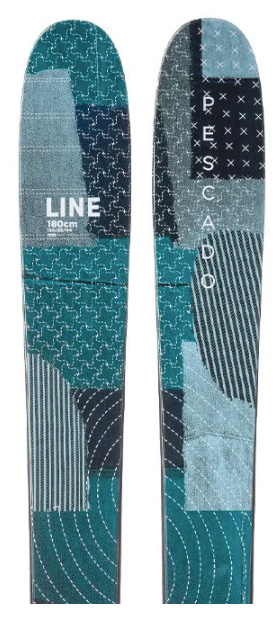 Ability level: Advanced to expert
Ability level: Advanced to expert
Dimensions: 158-125-144mm
Length: 180cm
What we like: Unique swallowtail design maximizes float and control in deep powder.
What we don’t: Only offered in a single length, which won’t work for some riders.
Deep-snow enthusiasts are likely familiar with the unfettered joy that comes from playfully navigating deep powder, and Line Skis’ Pescado is one of the best tools for the job. The unique swallowtail design is intended to sink the tail deeper into the snow while keeping the tip afloat, allowing for excellent control while simultaneously enhancing carving capabilities in more moderate conditions and on groomers (the tail is quick to release). A super-wide, 158-millimeter shovel and soft flex in the tip add to the ski’s float and surfability, while the stiffer tail makes turning a breeze. Taken together, the Pescado is supremely fun and a great match for off-trail riders who like to get creative.
There’s no denying the all-around fun factor of Line's Pescado, but unfortunately, the ski is only offered in a single 180-centimeter length, which won’t work for some riders. If you prefer something a little shorter and more maneuverable, we recommend checking out Line's Sakana, which is the Pescado’s narrower all-mountain counterpart that’s offered in 166, 174, and 181-centimeter options. Like the Pescado, the Sakana boasts the unique swallowtail design for maximizing float, and the 105-millimeter waist is a nice match for an all-rounder. But if you spend most of your time off-piste and can make the 180-centimeter length work, the Pescado offers far more playfulness and float.
See the Line Skis Pescado
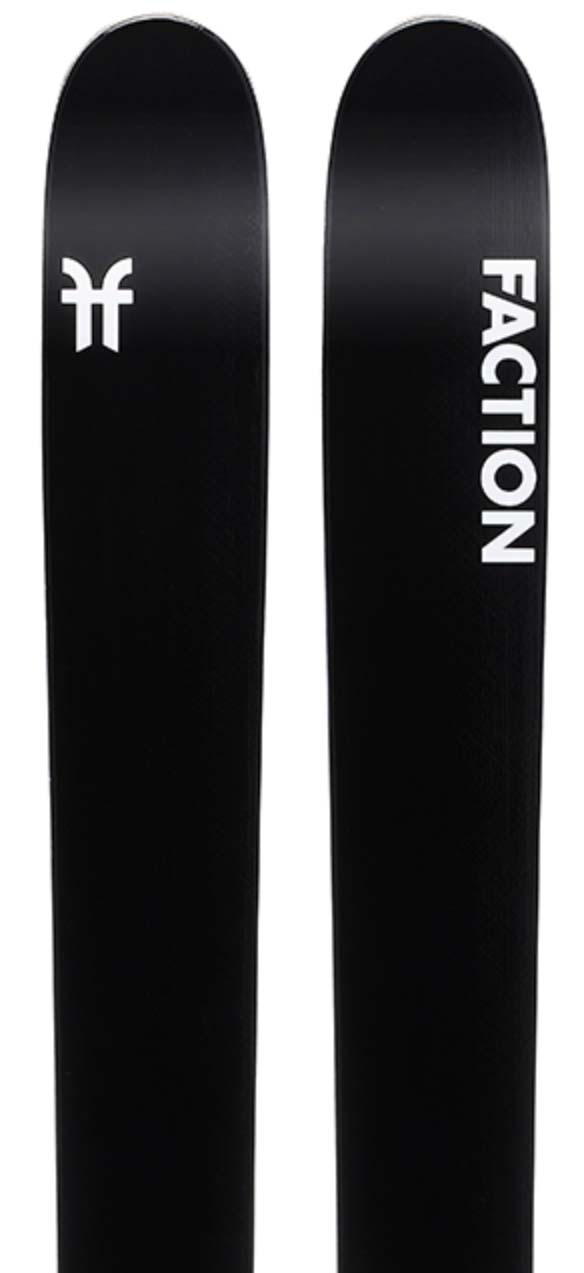 Ability level: Intermediate to advanced
Ability level: Intermediate to advanced
Dimensions: 148-126-139mm
Lengths: 178, 186, 192cm
What we like: Purpose-built for surfing deep powder.
What we don’t: Limited versatility, especially in crud.
With a 126-millimeter waist (the widest on our list), Faction’s La Machine 5 is purpose-built for one thing: surfing the deepest powder in the world (think places like Japan, Alaska, and British Columbia). Based in the freeskiing mecca of Verbier, Switzerland, Faction was born out of a resistance to alpine racing in pursuit of freedom and adventure in the mountains. Their La Machine 5 (formerly called the La Machine Max) pays tribute to that goal, combining generous dimensions, lightweight materials, and a reverse camber shape to skillfully navigate deep snow. Floatation is excellent thanks to the wide base and softer flex at the tip, and stiffer materials underfoot (including two layers of carbon) help maintain stability and maneuverability while keeping weight to a minimum.
As we mentioned above, Faction created the La Machine 5 for the sole purpose of skiing deep powder. While this translates to excellent float in prime backcountry conditions, the ski’s shorter effective edge will feel a bit squirrely in hardpack and variable snow. In other words, the La Machine 5 is far less versatile than many other designs here and best suited for confident riders who frequent areas with consistent and generous snowfall. If the size feels a little intimidating or you’re looking for more of an all-rounder for mixed conditions, Faction’s La Machine line includes a number of narrower options, from the 91-millimeter La Machine 1 (previously called the Micro) up to the 117-millimeter La Machine 4.
See the Faction La Machine 5
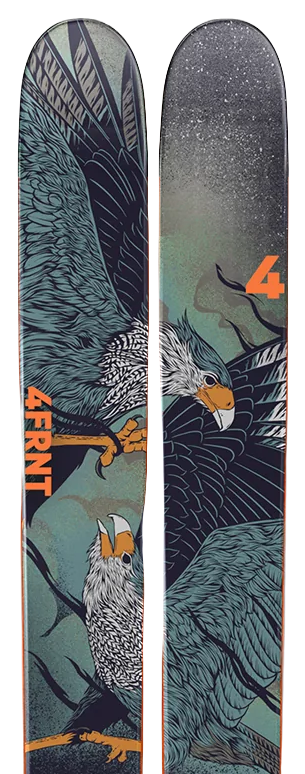 Ability level: Intermediate to advanced
Ability level: Intermediate to advanced
Dimensions: 135-122-129mm (177cm)
Lengths: 177, 184, 191cm
What we like: A near-ideal balance of weight and stability.
What we don’t: Too wide for some; we’d love to see more length options.
Eric “Hoji” Hjorleifson is one of the world’s premier freeskiers, and his powder tool of choice is the 4Frnt Renegade. It’s easy to see why: Designed for high speeds, nimble turning, and big drops, the Renegade is one of the most capable big-mountain freeride designs around. In short, the ski is most at home when moving fast through ungroomed, steep terrain rife with cliffs, pillows, and chutes—the type of conditions expert skiers seek when pushing the boundaries. That said, it’s still fairly light and nimble thanks to the aspen/maple core and fully rockered profile, which is great for intermediate riders who still want good maneuverability and top-end control. The result: A ski that likes to float yet is smooth and predictable at speed.
It's worth noting that the 4Frnt Renegade has a recommended center mount, which provides a balanced and stable landing platform should you decide to go for big air. On the flip side, it’s not out of place on long backcountry missions thanks to the fairly lightweight construction. That said, the 122-millimeter-wide waist will be overkill for some, and the length options may not work for shorter riders. Of note: Stepping down in width to the popular Hoji (112mm at the waist) tacks on a 170-centimeter length build.
See the 4Frnt Renegade
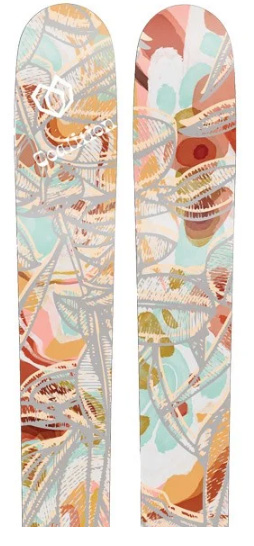 Ability level: Intermediate to advanced
Ability level: Intermediate to advanced
Dimensions: 137-115-132mm (172cm)
Lengths: 157, 164, 172, 180cm
What we like: A well-rounded ski that just happens to be crafted by women for women.
What we don’t: Relatively heavy for the size.
Coalition Snow has turned the shrink-it-and-pink-it mentality on its head to create a fantastic line of skis that are purpose-built by women and for women, and our favorite model this year is their Rafiki. Early rise in the tip promotes a surfy and playful ride in soft snow, while the slightly rockered tail assists with float and turning. Additionally, the Rafiki boasts a dual-radius sidecut that’s shorter at the front for easy turn initiation and longer at the tail to maximize stability and control. Added up, the Rafiki is light and nimble through the trees but able to charge hard through crud, which is no easy feat. Finally, we love the eye-catching but classy topsheet design, which gives the ski a decidedly high-end and elegant look.
The Coalition Rafiki is a resort-specific powder ski that transitions decently well for backcountry use, but it’s not the lightest option for long days on the skin track. If you’re searching for more of a crossover powder design, we recommend checking out Coalition’s own La Nieve. Compared to the Rafiki, the La Nieve has a similar shape and profile but is slightly narrower at the waist (109mm or 113mm depending on length) and lighter for off-piste use. No matter which option you choose, we applaud Coalition for their efforts toward making skiing more accessible and inclusive, regardless of ability level or gender identity.
See the Women's Coalition Snow Rafiki
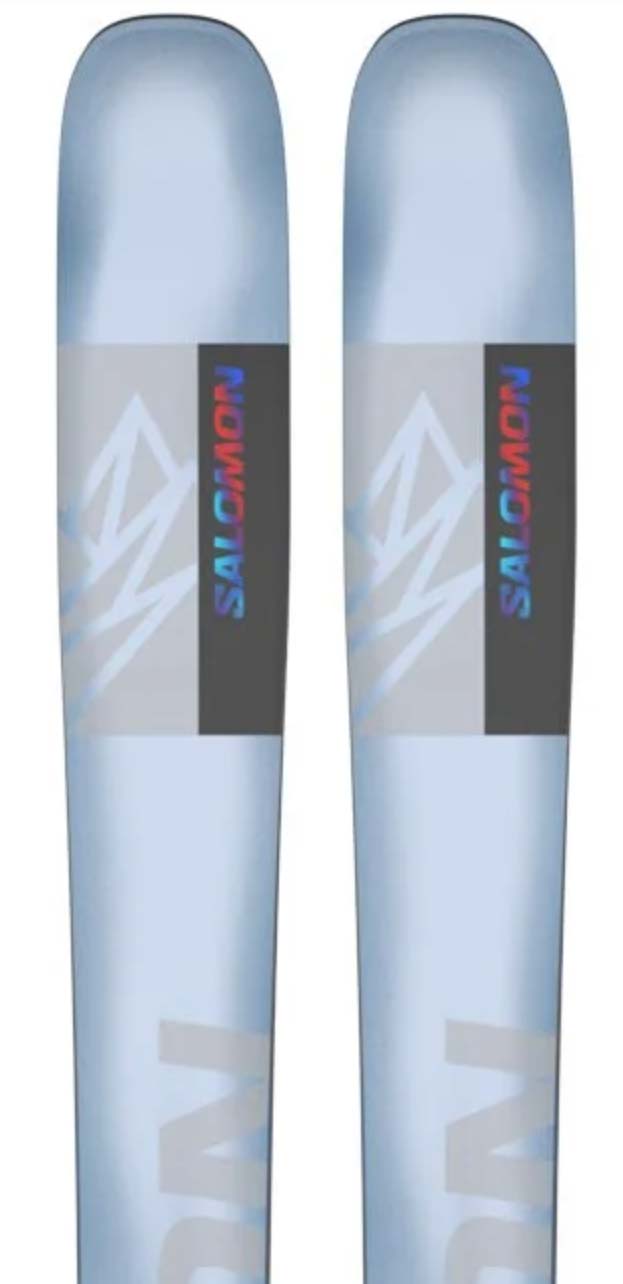 Ability level: Advanced
Ability level: Advanced
Dimensions: 137-112-126mm (178cm)
Lengths: 178, 186, 194cm
What we like: Highly versatile in a wide variety of conditions.
What we don’t: Requires skiers to take charge in heavy, chopped-up snow.
When Salomon tasked its athletes with creating a powerful but playful freeride ski, the result was the now wildly popular QST Blank. With a moderately wide 112-millimeter waist, 137-millimeter shovel (in the 178cm length), and rocker-camber-rocker profile, the QST Blank is impressively poppy and fun in powder. Carbon at the tip and tail help balance things out by providing great power transfer, while cork at the tip and a poplar core help dampen the ride and boost stability at speed. The result is a nimble-yet-stable ski that’s ready to pop off puffy pillows, drop into a tight couloir, or navigate the get-back with confidence and precision.
Given its versatility, the Salomon QST Blank borders on being an all-mountain powder ski. To be clear, that’s certainly not a knock on the ski—some may even consider it a benefit, depending on priorities. But if you’re looking for a true powder surfer and are willing to sacrifice some performance in variable conditions, you may be better off with a more specialized option like the top-rated Atomic Bent Chetler 120 or Faction La Machine 5 above. However, if you don't mind having a wide daily driver, the Salomon's versatility is hard to beat.
See the Salomon QST Blank
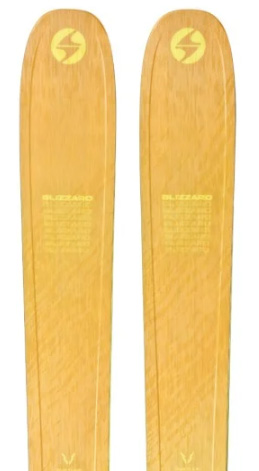 Ability level: Intermediate to advanced
Ability level: Intermediate to advanced
Dimensions: 140-112-130mm (180cm)
Lengths: 168, 174, 180, 186, 192cm
What we like: Predictable and easy to pivot in tight trees; a dream in soft snow.
What we don’t: Slightly less stable at full throttle than its predecessor.
Blizzard’s Rustler 11 lives at the intersection of freeride (think: hucking, stomping, charging) and powder (more like floating, surfing, and smearing). With a relatively moderate 112-millimeter waist, the Rustler 11 aims to do it all—and in most ways succeeds—striking a fine balance between freeride, powder skiing, and even holding its own in firmer snow. Already a longtime fan favorite, the Rustler 11 got a big update last season (spoiler alert: It's largely good news). The key difference is in the construction, where Blizzard shifted a layer of Titanal from the ski’s center to the perimeter while placing a separate metal sheet underfoot. Additionally, Blizzard incorporated its “Trueblend” wood core, which uses different types of woods to dial in flex in targeted areas. Finally, Blizzard shortened the Rustler 11’s length and raised the tip and tail rocker just a smidge, giving it a shorter feel. The result? The latest Rustler 11 floats better and is nimbler in trees and chutes than its predecessor.
Fans of the old Rustler will be happy to know the newest version sacrifices little of the versatility that’s made it so popular over the years. It’s predictable and smooth, delivers trustworthy edge grip on firm snow, and pivots intuitively through moguls. That said, the ski’s slightly shorter turn radius and less ground contact sacrifices a small amount of stability if you’re flooring it through the runout zone (the previous Rustler 11 was a freight train while straight-lining though heavy chop). Alas, there’s always a trade-off, but we think the boost in maneuverability is worth it.
See the Blizzard Rustler 11 See the Women's Blizzard Sheeva 11
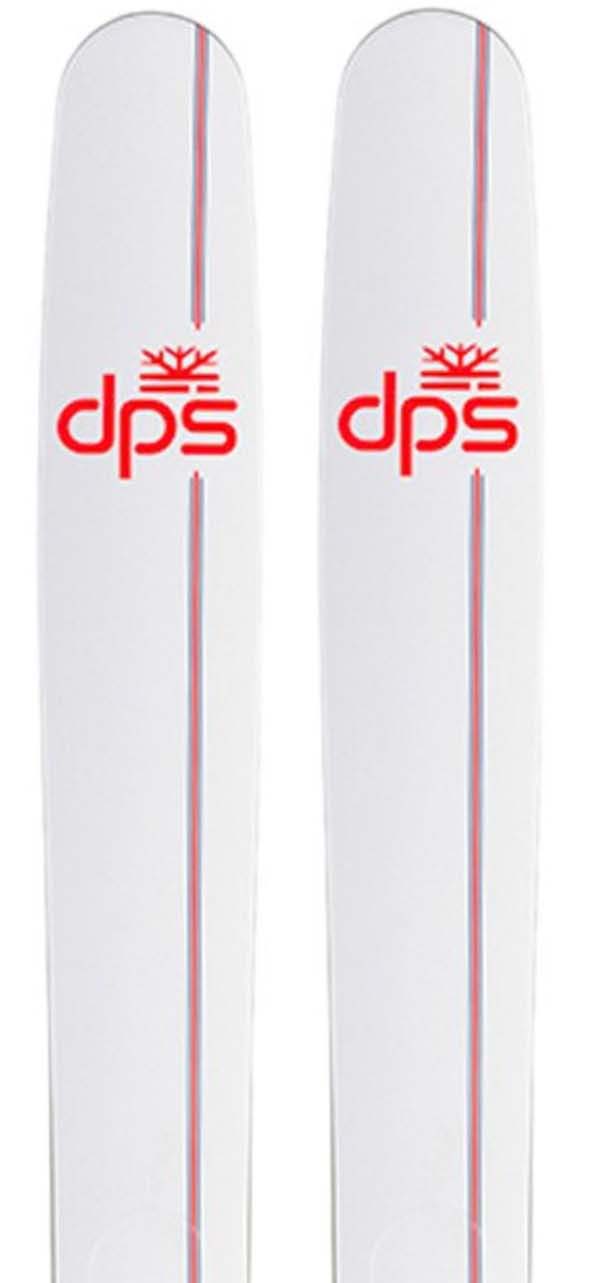 Ability level: Advanced to expert
Ability level: Advanced to expert
Dimensions: 140-124-130mm (179cm)
Lengths: 179, 185, 191cm
What we like: DPS’ classic powder-loving shape in a fun, lightweight package.
What we don’t: The most expensive ski here.
If you’re dreaming of heli-skiing in Alaska, going on a hut trip to British Columbia, or cruising the backcountry in Hokkaido, Japan, DPS’ Carbon Lotus 124 should be on your radar. Simply put, there’s a reason that many riders consider this ski to be the best option on the market for bottomless snow days. Along with the wide waist, tapered tip, and powder-ready shape that DPS is known for, the Carbon Lotus 124 boasts a gradual rocker profile that allows the ski to glide smoothly across the snow’s surface, nimbly navigate turns, or stomp a big-air landing. Tack on the fact that it’s impressively light for its size, and there are very few limits to what the Carbon Lotus can do.
All that said, the impressive powder performance does come with some serious sticker shock. At nearly $1,700, the Carbon Lotus 124 is the most expensive ski to make our list by a sizable margin, and many powder-hungry riders will be perfectly happy saving with Faction’s La Machine 5 or Atomic’s Bent Chetler above. But that’s certainly not a knock on quality or overall capabilities—DPS is one of the most revered names in the ski industry and has a reputation for their excellent craftsmanship. And if you like the Lotus shape but can’t justify the huge 124-millimeter waist, there’s now a slightly trimmed-down Carbon Lotus 117 available (although it won't save you any cash).
See the DPS Carbon Lotus 124
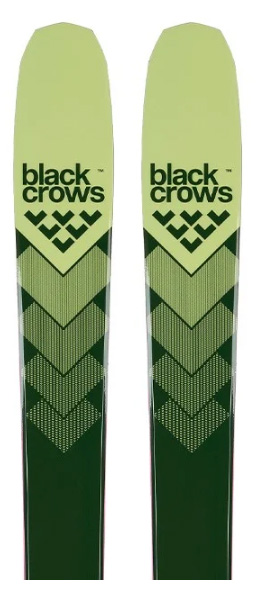 Ability level: Intermediate to advanced
Ability level: Intermediate to advanced
Dimensions: 145-115-135mm (182.1cm)
Lengths: 176.6, 182.1, 189.2, 194.4cm
What we like: Carves soft groomers as well as it floats.
What we don’t: Heavy and difficult to throw around.
If skis were people, something tells us that the Black Crows Anima would be the life of every party. With a progressive flex that’s softer at the tip and tail, double rocker, and camber underfoot, the Anima is a playful ski that loves to surf, has no problem staying afloat, can pivot through the trees, and will spring and bounce through open bowls. Unlike many playful designs, however, the Anima still offers ample stiffness, edge hold, and precision to charge through chop and carve on hardpack. And this is a matter of personal preference, but we love Black Crows’ subdued but classy styling that adds a nice dose of flair.
No ski is perfect, however, and the Anima is no exception. At just under 10 pounds for the pair, it's the heaviest option to make our list (the Völkl Revolt 121 isn't far off) and noticeably harder to throw around than lighter-weight designs like the Faction La Machine 5 and DPS Carbon Lotus above. It’s worth noting that a few of our female testers mounted the women’s version of the ski (the Anima Birdie) with tech bindings last season and had no complaints using it as their primary backcountry powder ski, but those who spend a lot of time on the skin track will likely want to go lighter. However, the solid feel and carving abilities are clear highlights for hard chargers who prioritize performance on the descent.
See the Black Crows Anima See the Women's Black Crows Anima Birdie
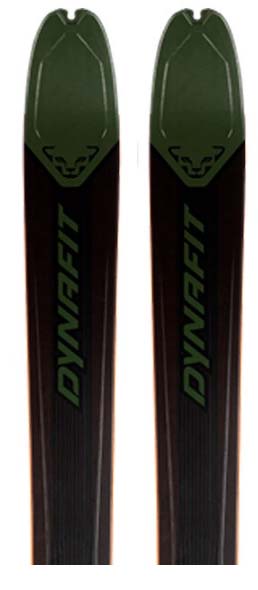 Ability level: Advanced to expert
Ability level: Advanced to expert
Dimensions: 138-113-128mm (180cm)
Lengths: 180, 188cm
What we like: A descent-oriented freeride ski that’s light enough for touring.
What we don’t: For a unisex ski, the length options are limited.
Dynafit has been at the forefront of light-and-fast ski touring for decades, from its pin bindings to extremely light ski mountaineering and skimo racing boots. If you wanted the lightest (yet reliable) ski gear, Dynafit was the go-to provider. Yet, the backcountry population has exploded in recent years, and at the same time, the ultralight space has gotten more crowded. In addition, while weight is an important consideration for touring, you can now find a lot of strong downhill performers that are still nimble and quick on the uphill. With all of this change, we’re excited to see Dynafit is responding to the wants and needs of the broader backcountry community by introducing more downhill-oriented designs like the Tigard 114, which debuted last season.
Although Dynafit has been offering wider ski options over the past several years (up to a 108mm waist), this is quite a jump for any European-based ski brand, which tend to call anything wider than 85 millimeters a “powder” ski. Getting into the details, the Tigard’s poplar core and carbon stringers give it liveliness and stability, while full sidewalls boost its durability and edge-to-edge power in choppy or unpredictable snow. A rockered tip and tail along with a moderately wide platform (138mm at the shovel in the 180cm length) guarantee fun in powder, while camber underfoot grips reliably on hardpack. We do wish more length options were available, and the Tigard still can’t match the Bent Chetler’s weight-to-performance ratio (in a plot twist, it’s far heavier than the Atomic). But we love to see Dynafit really jumping into the crossover resort and backcountry powder market with a well-rounded effort.
See the Dynafit Tigard 114
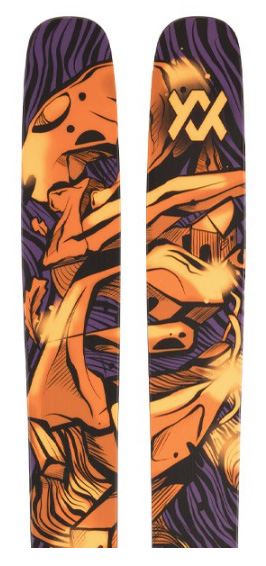 Ability level: Advanced to expert
Ability level: Advanced to expert
Dimensions: 143-121-135mm
Lengths: 177, 184, 191cm
What we like: Among the best for hot laps on bottomless days.
What we don’t: Large size limits its application.
If you’re a powderhound who’s frothing at first chair and shreds hot laps until every pocket of fresh has been slashed, the Völkl Revolt 121 is the ski for you. This ski’s giant platform will keep you afloat on anything, while its underfoot camber provides enough energetic pop to pivot through trees and bounce down pillow lines—all while breaking both the speedometer and the funmeter. Full-length sidewalls and a beech-and-poplar core ensure that the Revolt will remain powerful while taking a beating, so go ahead and huck that drop you’ve been eyeing from the lift and know that this ski can stomp the landing.
While it can ride over almost anything and blast through the rest, the Revolt’s size does somewhat limit its application: Unless you’re regularly skiing fresh powder and big terrain, it’s probably more than you need. Furthermore, at around 10 pounds, it’s one of the heaviest skis on our list. For reference, our top-rated Bent Chetler 120 is nearly 2 pounds lighter and sacrifices essentially none of the performance (4Frnt's Renegade and Faction’s La Machine 5 are two additional big-ski options that weigh less). As such, the Revolt 121 isn’t our top pick as a crossover ski if you’re looking for something to take into the backcountry. However, we’d stop short at calling this ski heavy: It’s still light enough to take to the air but has enough heft to blast through the runout without slowing down.
See the Völkl Revolt 121
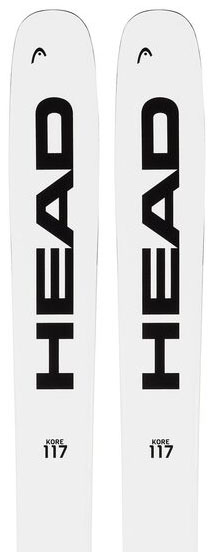 Ability level: Advanced to expert
Ability level: Advanced to expert
Dimensions: 145-117-129mm (184cm)
Lengths: 177, 184, 191cm
What we like: Light for its size yet still very capable.
What we don’t: Less of a standout than many other options here.
Most powder skis aimed at tacking big lines are relatively heavy, but Head's Kore 117 bucks that trend by combining light but strong materials to keep weight reasonably low. To be sure, the Kore is no featherweight at around 8.5 pounds per pair, but the mix of graphene, carbon, and caruba/poplar woods offers a nice balance between power and agility. Other notable features include a wide 24.6-meter turn radius for long, sweeping turns in powder and subtle rocker at the tip and tail for maximizing float on all but the deepest of days. All told, the Kore is fast, stable at high speeds, and offers much more precision than its weight would suggest.
That said, our overall take on the Head Kore 117 is that it lands in an awkward in-between space: It’s not as burly or damp as options like the Moment Wildcat or Salomon QST Blank above, nor does it float quite as well as the Atomic Bent Chetler 120, Line Pescado, or Black Crows Anima. Intermediate riders should also steer clear, as the Kore is decidedly stiff and tough to control in tight spaces. But if you’re an experienced skier and don’t mind putting in the work, the Kore offers a highly competitive balance of speed and off-piste performance for the weight.
See the Head Kore 117
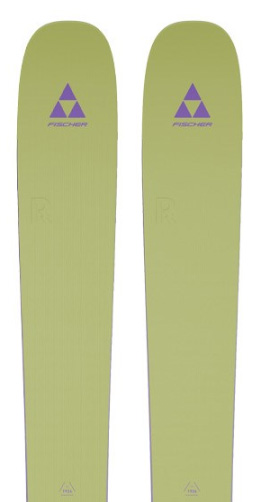 Ability level: Advanced to expert
Ability level: Advanced to expert
Dimensions: 145-115-135mm (180cm)
Lengths: 180, 187, 193cm
What we like: Good versatility in a wide range of conditions.
What we don’t: Stiff and takes a strong rider to drive.
Fisher’s Ranger lineup is highly respected among those in the know–ski patrollers, guides, and avid riders alike. The widest option in the collection is the Ranger 116, a freeride powder ski that’s most at home in deep snow but can hold its own all over the mountain. The ski is shaped with a directional rocker profile to ease turn initiation, while the beech/poplar wood core and strategically placed Titanal aim to balance flex and power (with mixed results). On the snow, the result is a ski that goes fast wherever you point it; floats, carves, and pivots through tight terrain features; and remains stable and balanced in nearly all conditions.
All that said, the Fischer Ranger 116 is not for the casual skier who likes to sit back and relax—the stiff and relatively heavy build requires a strong and capable pilot to control, especially at speed. Additionally, if your top priorities include float and playfulness, you’ll likely be better off with a wider and softer option like Faction’s La Machine 5 or Line's Pescado above. However, if your ideal day involves carving big-mountain freeride turns and blasting through the crud at the bottom of the run, the Ranger 116 is up to the task.
See the Fischer Ranger 116
| Ski | Price | Ability Level | Dimensions* | Weight (pair)* | Radius* |
|---|---|---|---|---|---|
| Atomic Bent Chetler 120 | $850 | Advanced to expert | 143-120-134mm (184cm) | 3600g | 19m |
| Moment Wildcat | $849 | Advanced to expert | 141-116-131mm (179cm) | 4120g | 23m |
| Line Skis Pescado | $900 | Advanced to expert | 158-125-144mm (180cm) | 3900g | 19.5m |
| Faction La Machine 5 | $949 | Intermediate to advanced | 148-126-139mm | 3780g | 24m |
| 4Frnt Renegade | $1,039 | Intermediate to advanced | 135-122-129mm (177cm) | 3892g | 30m |
| Coalition Snow Rafiki | $799 | Intermediate to advanced | 137-115-132mm (172cm) | 4082g | 20m |
| Salomon QST Blank | $800 | Intermediate to advanced | 137-112-126mm (178cm) | 4080g | 16m |
| Blizzard Rustler 11 | $850 | Intermediate to advanced | 140-112-130mm (180cm) | 4000g | 19m |
| DPS Carbon Lotus 124 | $1,696 | Advanced to expert | 140-124-130mm (179cm) | 3830g | 23m |
| Black Crows Anima | $1,100 | Intermediate to advanced | 145-115-135mm (182.1cm) | 4500g | 19m |
| Dynafit Tigard 114 | $900 | Advanced to expert | 138-113-128mm (180cm) | 3740g | 23.5m |
| Völkl Revolt 121 | $750 | Advanced to expert | 143-121-135mm (177cm) | 4440g | 18.9/17.4/18m |
| Head Kore 117 | $899 | Advanced to expert | 145-117-129mm (184cm) | Unavail. | 24.6m |
| Fischer Ranger 116 | $900 | Advanced to expert | 145-115-135mm (180cm) | 4040g | 19m |
*Editor's note: Dimensions, turn radius, and weight often vary depending on the length of the ski, and we used the length closest to 180cm (with the exception of the women's-specific Coalition Snow Rafiki) for the sake of comparison above.
Deep snow requires specialized gear and a lot of time testing on a variety of different slopes. Fortunately, our team has the time and skills to put these powder tools through many laps during the season. Contributing editor and avid skier Alli Hartz put together our initial list of 18 top powder skis in 2022, drawing from years of experience ski guiding and teaching avalanche courses throughout the Pacific Northwest. Senior editor Chris Crossen joined the team in 2024 and now oversees the guide, contributing his expertise as a lifelong backcountry and resort skier currently based in the Lake Tahoe area. Our extensive network of freelancers helps fill in the gaps, ensuring we cover the full gamut of riders and snow conditions.
Our current lineup of 14 powder-ready designs reflects our ongoing experiences on the snow, firsthand info from testers and gear-savvy friends, and feedback from the online skiing community. When we test skis, we look closely at overall construction and quality as well as key performance characteristics, including maneuverability, float, playfulness, stability, and more. Oftentimes, we test multiple skis at once in order to draw accurate comparisons between models. Since the market is very dynamic, with companies releasing and tweaking designs fairly frequently, we continue to test new and noteworthy skis as they become available, adding any standouts to the list above.
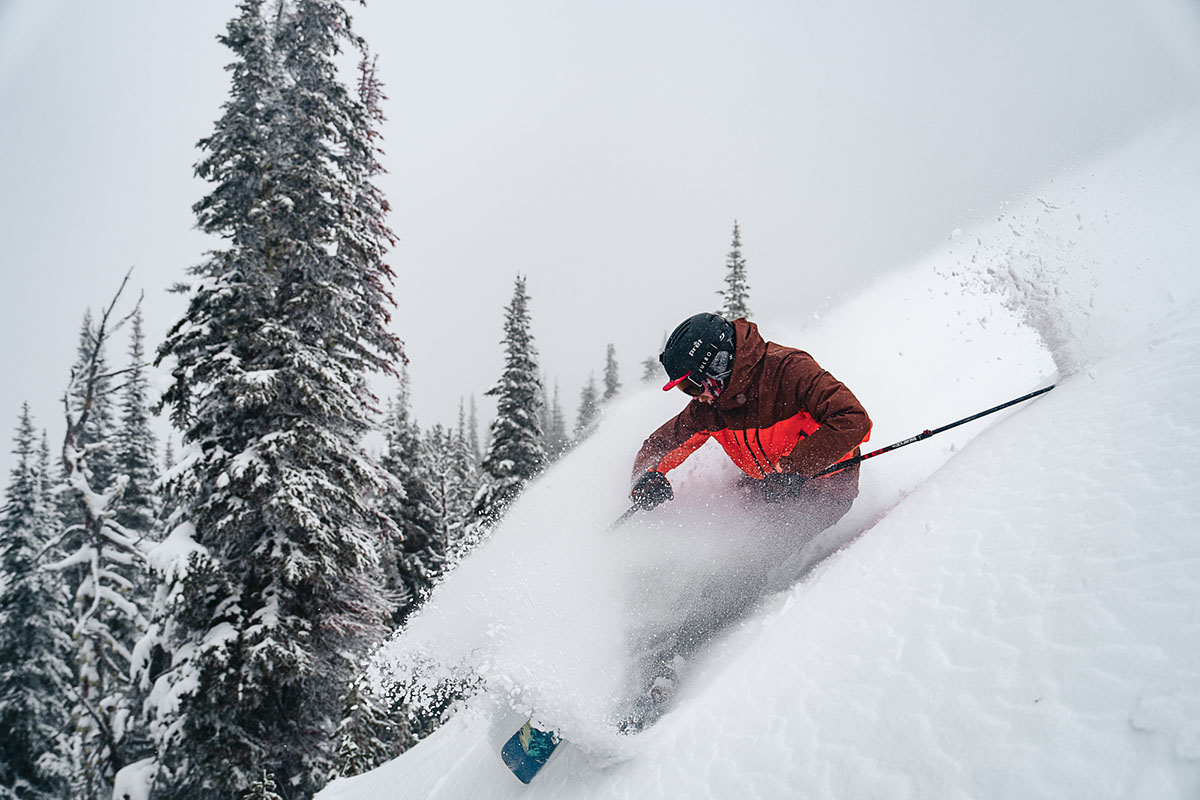
Generally speaking, powder skis are designed with a wider shape than resort and all-mountain models to help skiers stay afloat in deep snow. In terms of construction, they often have a wide, rockered tip (or “shovel”), more width underfoot (typically around 110-120mm), and a wide tail to enhance float and make it easier to turn in deep, ungroomed snow. This allows riders to maintain speed and make turns without sinking into the snow—and there’s no denying the all-around fun factor.
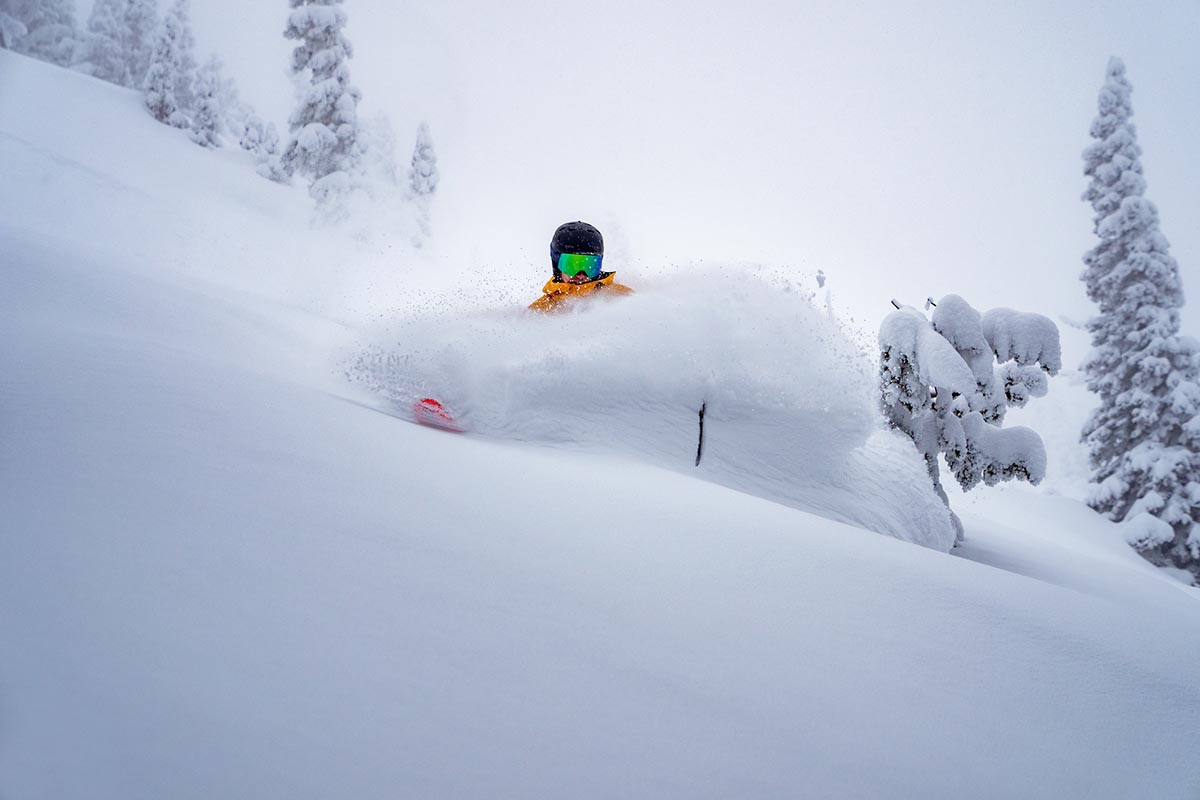
However, that specialized nature means that powder skis aren’t the most versatile option available, nor are they the best pick for beginners who are still honing their skills at the resort. In general, wider powder skis don’t carve as well as narrower designs on groomed runs or hold an edge as effectively on hardpack or icy snow. Many modern powder skis do have added stiffness in the construction to enhance performance in firmer conditions, but this can make them harder to turn, especially without the proper technique. For that reason, beginners and those looking for a do-it-all ski will likely be better off with a more well-rounded all-mountain design. On the flip side, powder skis make a lot of sense for intermediate to expert riders who frequently venture off-piste or into the backcountry to seek out untracked terrain (and who likely already have a couple other pairs of skis in their quiver).
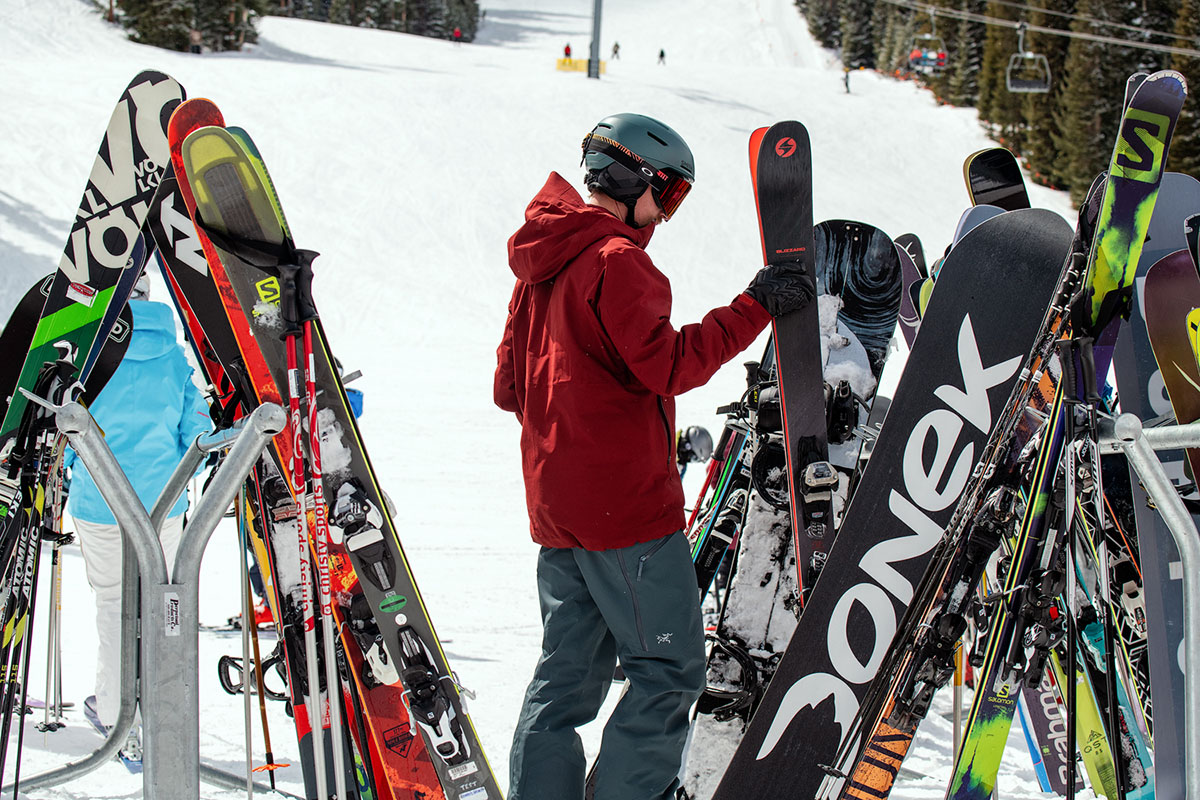
As we mentioned above, powder skis have wide shapes and generous dimensions (i.e., more surface area) to help skiers stay afloat and maintain speed in deep snow. That said, as the ski industry has learned over the years, wider does not always equal better. In recent years, most brands have settled on widths of around 110 to 120 millimeters underfoot, although skis up to 125 millimeters are not uncommon in areas with consistently deep powder (think destinations like Alaska, British Columbia, and Japan). For reference, the widest model on our list above is Faction's La Machine 5 at 126 millimeters underfoot, while the Salomon QST Blank and Blizzard Rustler 11 (both 112mm) are tied for the narrowest—and predictably, the Faction has a very different personality.
In addition to a wider platform underfoot, powder skis generally have wide tips that measure around 140 to 155 millimeters. The tails are only slightly narrower, often in the 125– to 140-millimeter range. Like anything with a relatively large surface area, this shape helps powder skis stay afloat in deep, soft snow. That said, the exact shape and profile of a ski’s tip, waist, and tail can differ dramatically between models. There are also several other factors that contribute to how well each ski will float, including flex, the materials used, and more. In other words, dimensions are just one part of the equation and should be looked at in conjunction with the rest of a ski’s makeup.
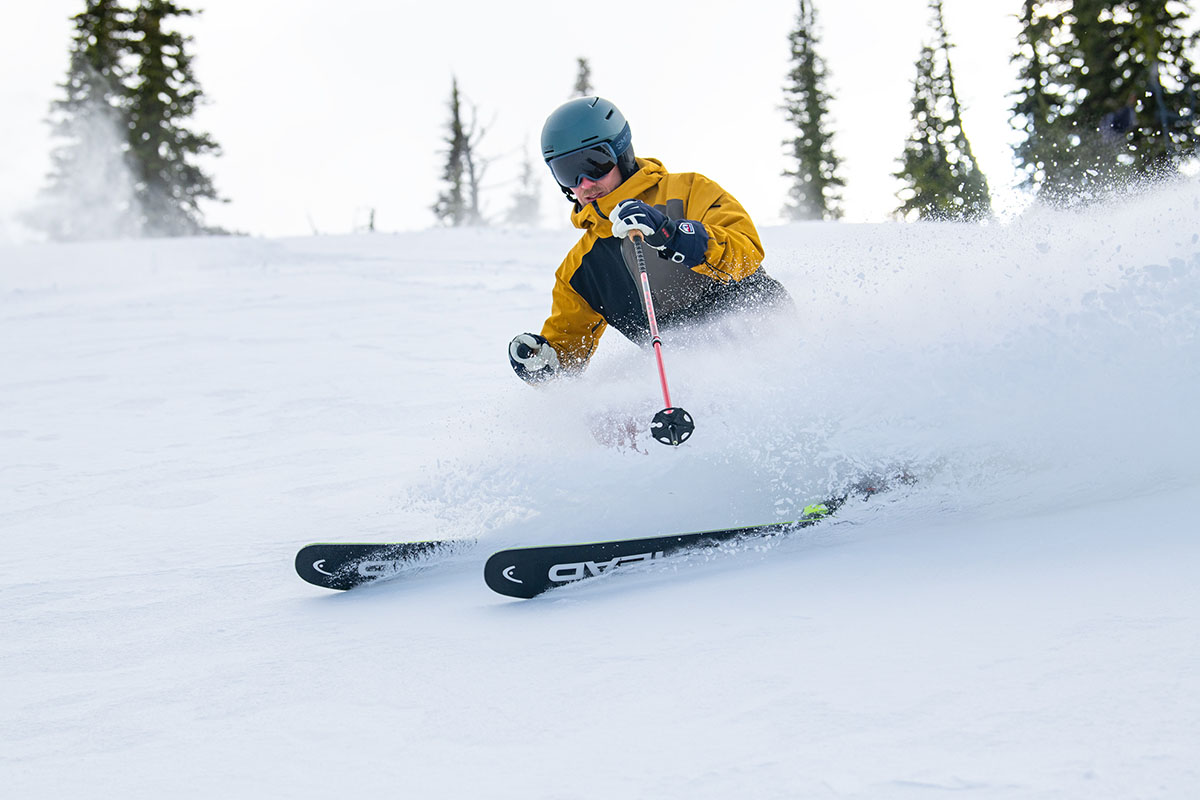
The profile of a ski can be broken into three main categories: camber, rocker, and mixed rocker/camber. There are others, including skis with a flat bottom shape, but the three listed below are the most popular—and for good reason. Each has their own strengths and weaknesses for skier and snow type.
Camber
Camber is a slight arc in a ski that has its high point underneath the foot. Visually, this is the part of the ski that is raised off the ground if the unweighted ski is laid flat on the snow surface (alternatively, if you hold two skis together vertically with the bases against each other, it’s where they bend away from each other). The purpose of camber is to help skiers maintain edge control while carving turns. When the cambered ski becomes weighted during the middle of a turn, the ski’s edge grips the snow surface. As the skier exits the turn, the camber helps the skier pop and propels them into the next turn. Traditional camber remains a great choice for those who like to ski aggressively on groomed runs, but it’s not very common among powder skis given the focus on float and playfulness.
Rocker
Rocker, also called reverse-camber, is exactly that—camber in reverse, curving downward from the top of the ski instead of up from the bottom (like a banana). Powder skis with this profile—like the 4Frnt Renegade on our list—typically are highly maneuverable, float well, and are pretty reliable and stable when punching through choppy snow. The downside of a pure rocker ski is the flat surface underfoot has a tendency to be more skittish on firmer surfaces. Although it turns easily, it just doesn’t hold an edge like traditional camber. From this issue was born a third category: mixed rocker/camber.
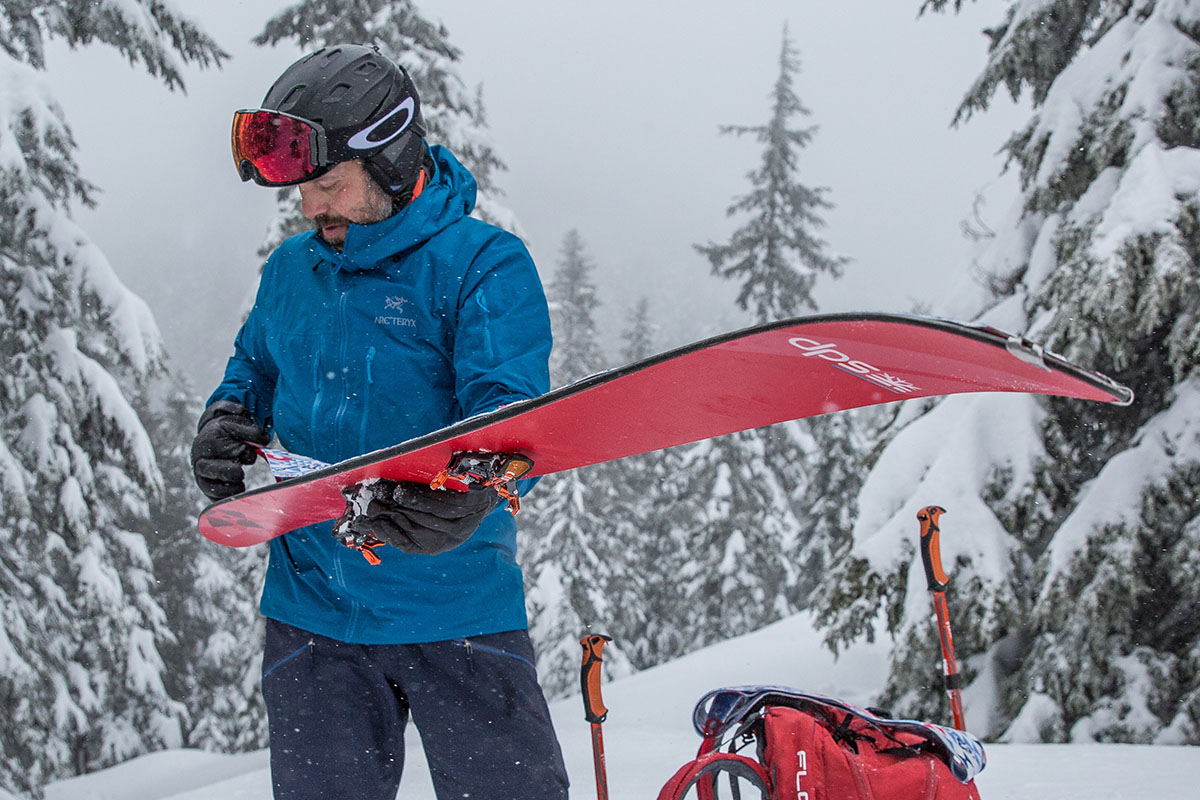
Mixed Camber/Rocker
In the mid 2000s, fully rockered skis and snowboards were popular for their unmatched maneuverability and flotation in deep snow. However, most modern powder skis have shifted to a mixed layout, with rocker in the tip and tail along with camber underfoot. In theory, this setup provides the best of both worlds: the pop and edge control of a traditional camber ski and the crud busting and easy cruising in deep powder that you get with rocker. If you want to maximize versatility and enjoy skiing a variety of conditions (not just deep powder), a mixed camber/rocker setup is a great pairing. One example is Salomon's QST Blank, which nicely balances nimbleness and stability and does a great job handling variable terrain and snow types.
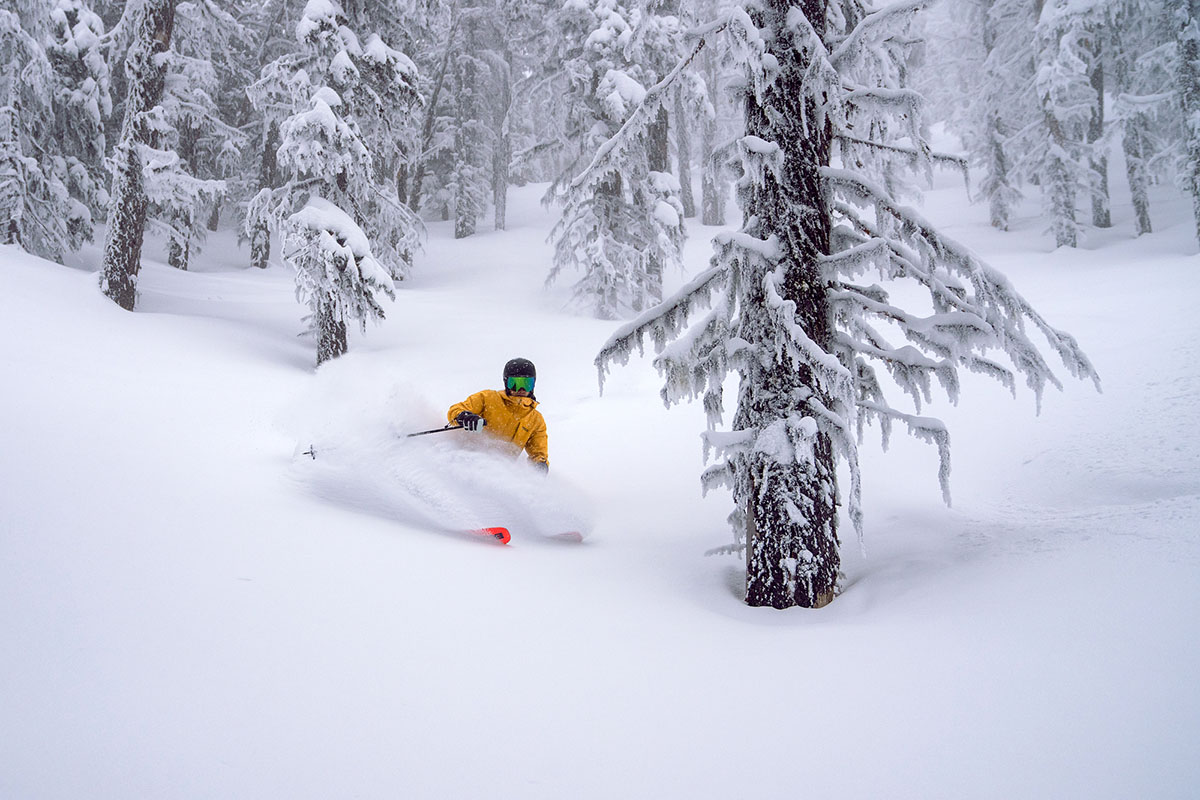
A ski’s sidecut (also referred to as turn radius) is measured in meters and determined by the shape and dimensions of its tip, waist, and tail. In short, the narrower a ski’s waist relative to its tip and tail, the deeper its sidecut and smaller its turn radius. A ski that’s built for quick, tight turns will have an hourglass shape that’s wider at the tip and tail and much narrower at the waist to maximize responsiveness and maneuverability. For example, Salomon’s QST Blank measures 138 millimeters at the tip, 112 millimeters underfoot, and 127 millimeters at the tail and has a medium length, 17-meter turn radius.
Powder skis typically have a medium-to-long turn radius of 16-20+ meters, which is largely to maximize float. If a ski is too narrow in the waist, it will sink down into deep snow and lose its ability to surf, pop, and do all the other fun things that powder skis are built to do. Powder skiing also often involves making wide, sweeping turns on big, open faces and bowls, which pairs well with a longer turning radius. A final benefit is top-end stability: Backcountry riders are always trying to keep their speed while staying on top of the snow, and a ski with a longer turn radius will help keep you afloat and maintain control while moving fast.
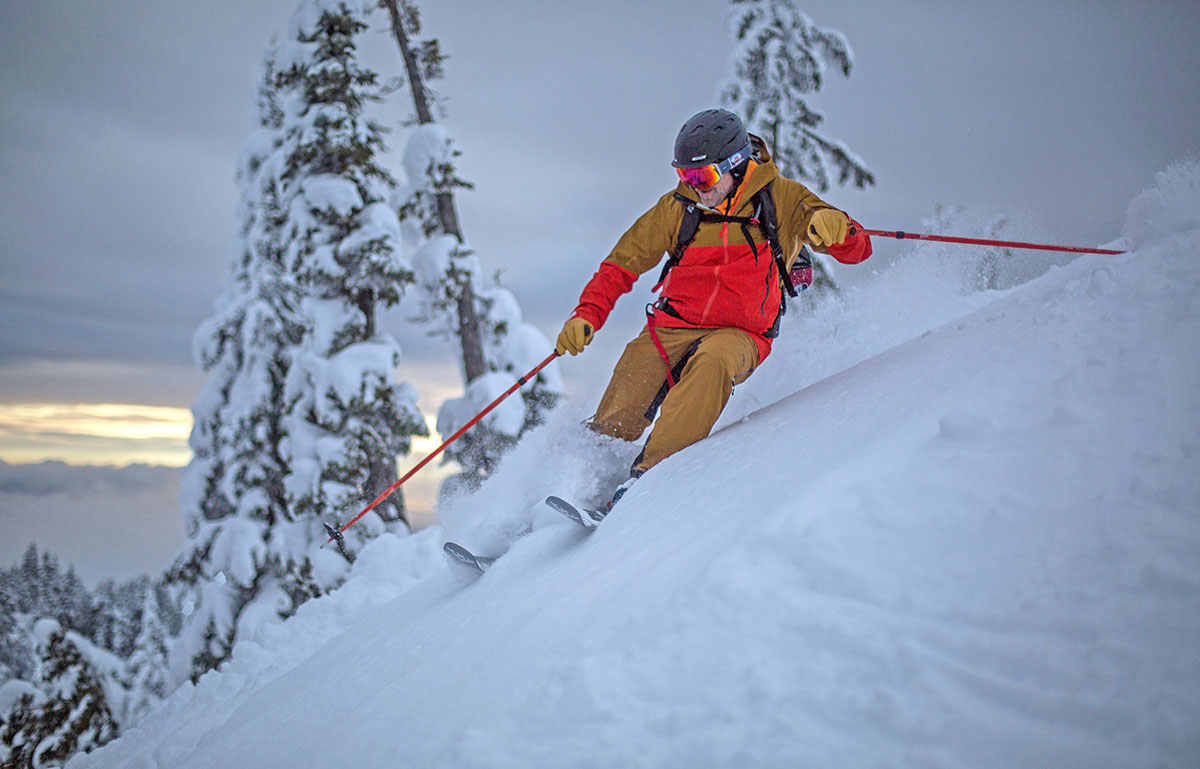
Why don’t all powder skis have minimal sidecut and the longest possible turn radius? Well, because most of us aren’t heli-skiing in Alaska. Sure, many riders frequent bowls, chutes, and open faces with untracked powder, but they’re also skiing powder through trees, glades, and other tight spaces where responsive turning is critical. As a result, when deciding on a pair of powder skis, it’s worth considering your preferred type(s) of terrain and what your ideal balance of playfulness versus stability looks like. A ski with a medium turn radius is going to be able to make quicker maneuvers, while one with a longer radius (like the aforementioned 4Frnt Renegade) will be slower to turn but more adept at high-speed charging. Our best advice is to avoid pigeonholing yourself into one type of terrain or riding style by steering clear of skis that swing too far in either direction (unless you're looking for very specialized performance).
Manufacturers utilize a range of methods to balance a ski's stiffness and power with playfulness and maneuverability, and we focus a lot of our write-ups above in describing the "feel" of each model (and what ability level and style of rider it's best for). A rigid design is stable at speed and has the highest performance potential, making it easier for confident riders to ski through variable or heavy, chopped-up snow. As a result, stiffer skis are typically best suited for advanced to expert skiers that like to move fast (and are confident doing so). Powder-ready options that fall into this category include the Moment Wildcat and 4Frnt Renegade.
On the other hand, a softer, more flexible ski will feel more playful and easier to turn, making it more approachable to intermediate riders (at the sacrifice of some high-speed stability and dampness in big mountain scenarios). Many of our favorite models land somewhere in the middle—including our top-rated Atomic Bent Chetler—balancing power for driving the skis with enough flex to be forgiving and maneuverable when moving at a slower clip.
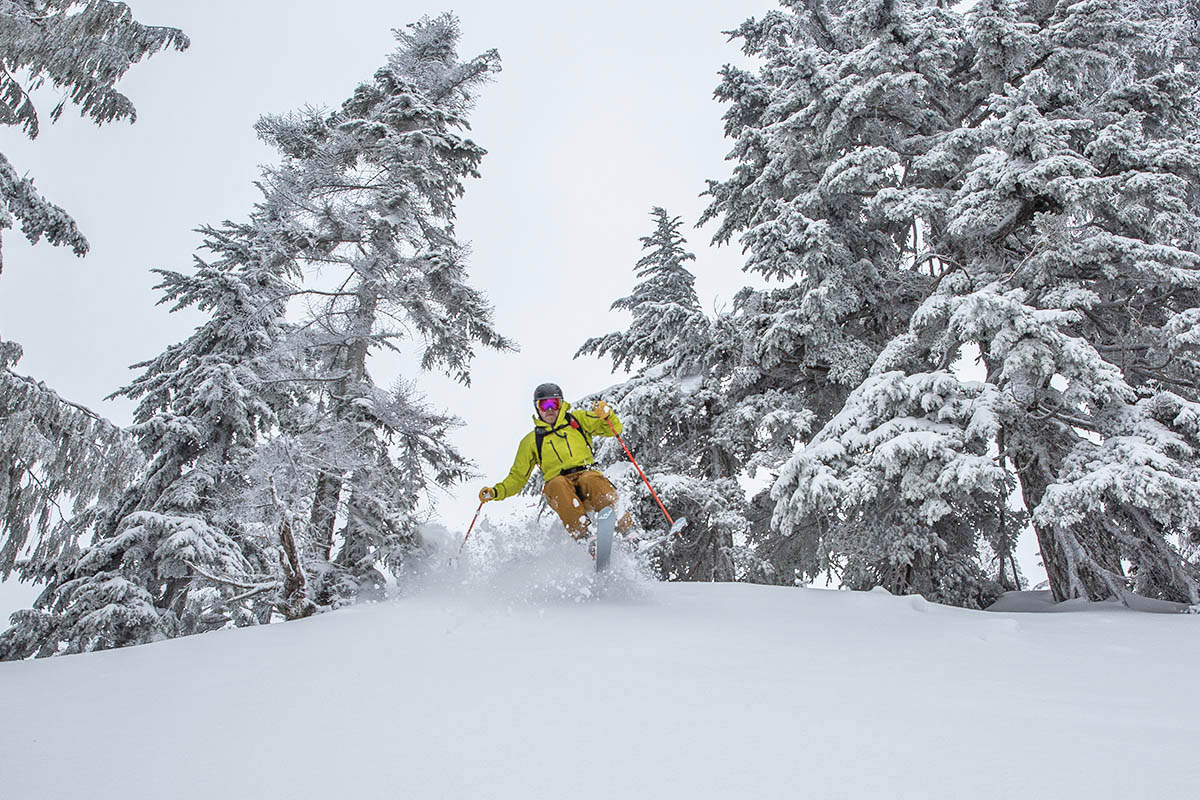
Given their generous dimensions, powder skis are a relatively heavy bunch, averaging around 4 to 5 pounds per ski. That said, unlike resort riding, where weight generally isn’t a huge factor for most, skiing in powder requires a reasonably light platform in order to maximize flotation. Your ideal number will vary depending on your priorities: Backcountry enthusiasts who like to earn their turns will likely want to stick to the lower end of the spectrum, and weight also becomes an important factor for riders who want one pair of skis to cross over for both resort and backcountry use. On the other hand, if stability and dampness take precedence, a heavier design will likely be your best match. We've included the listed weight of each ski in the table above, and the numbers range from the Black Crows Anima at 9 pounds 14.7 ounces per pair (in the 182.1cm length) down to the Atomic Bent Chetler 120 at 7 pounds 15 ounces (for the 184cm length).
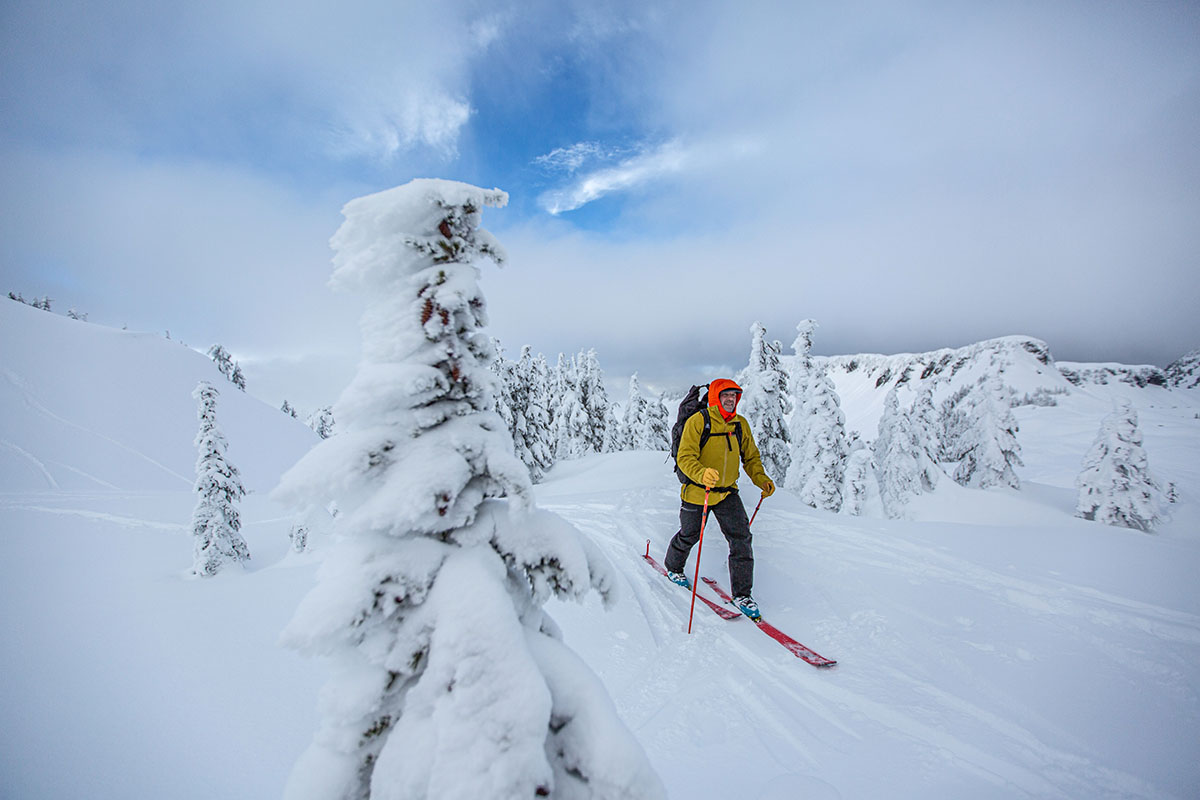
Modern powder skis are packed with high-end materials and proprietary technologies, which makes it nearly impossible to accurately analyze their constructions without putting them to the test. The good news is that the market in 2024 is flush with quality options, and each year we see incremental improvements. Poplar and aspen are two lightweight and high-energy woods commonly used in the core to reduce weight while maximizing pop and responsiveness. Paulownia is another lightweight option that’s often slightly more durable, while denser woods like maple will boost power, stability and durability but add some heft. Outside the core, ski manufacturers also often use some metal or composite materials—including graphene, carbon, Titanal, or proprietary blends—to increase a ski’s strength and stiffness.
Our best advice is to avoid limiting yourself by setting too many parameters. It’s hard to pinpoint performance simply based on a ski’s construction, and there are a wide variety of ways to make a capable design. When researching, pay attention to how the manufacturer and reviewers describe overall performance, but remember to take big claims with a grain of salt. If possible, it’s always helpful to demo skis with varying materials and constructions to see how they feel under your feet.
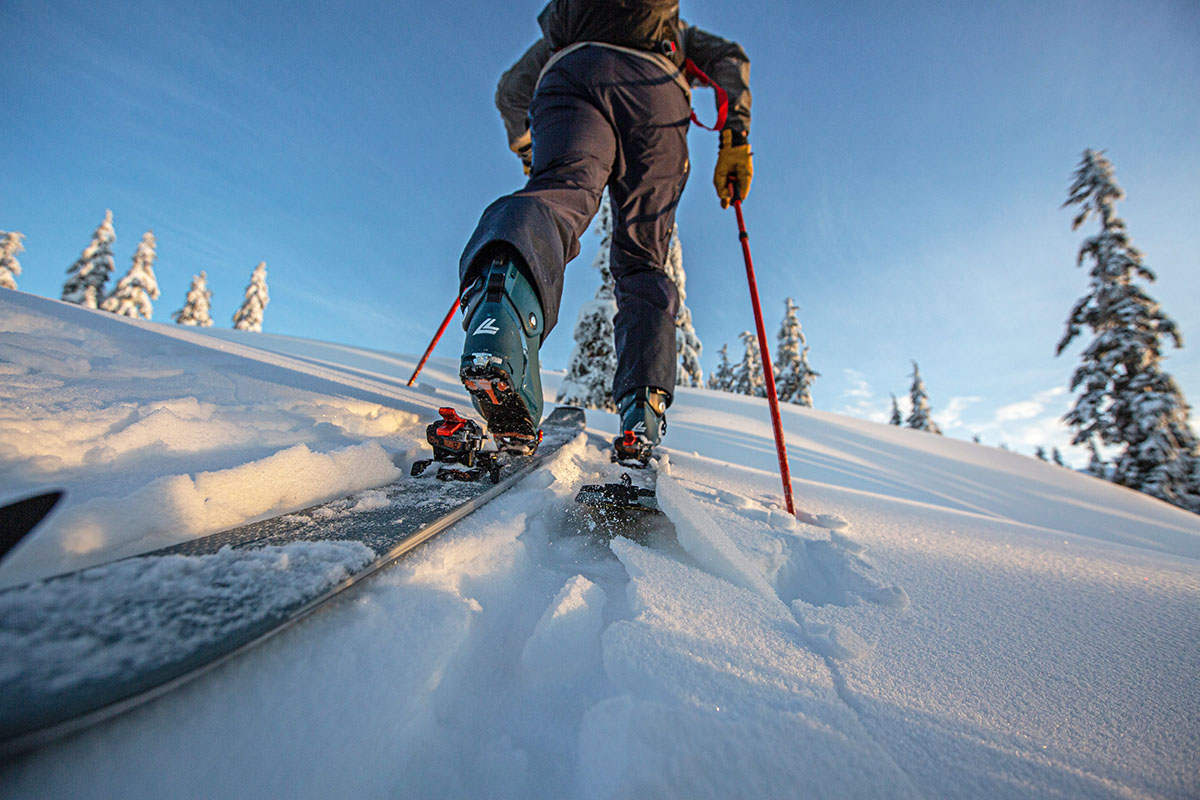
When choosing skis to use both at the resort and in the backcountry, the name of the game is versatility. Weight can be a good place to start: You’ll likely want a ski that’s at the lighter end of the resort category or a backcountry ski that’s relatively beefy. Our favorite crossover designs this year are Atomic’s Bent Chetler 120 and Dynafit’s Tigard 114, both of which are light enough to keep your legs fresh for the descent while offering great stability in less-than-ideal conditions (which you may find frequently at the resort). Backcountry missions also often involve some amount of variable snow, whether you’re making a few turns through chalky wind drift before reaching the powder below or slogging through afternoon mashed potatoes. In other words, it's often best to opt for more of a do-it-all ski than a specialist that’s crafted for a single purpose (e.g., surfing in deep powder).
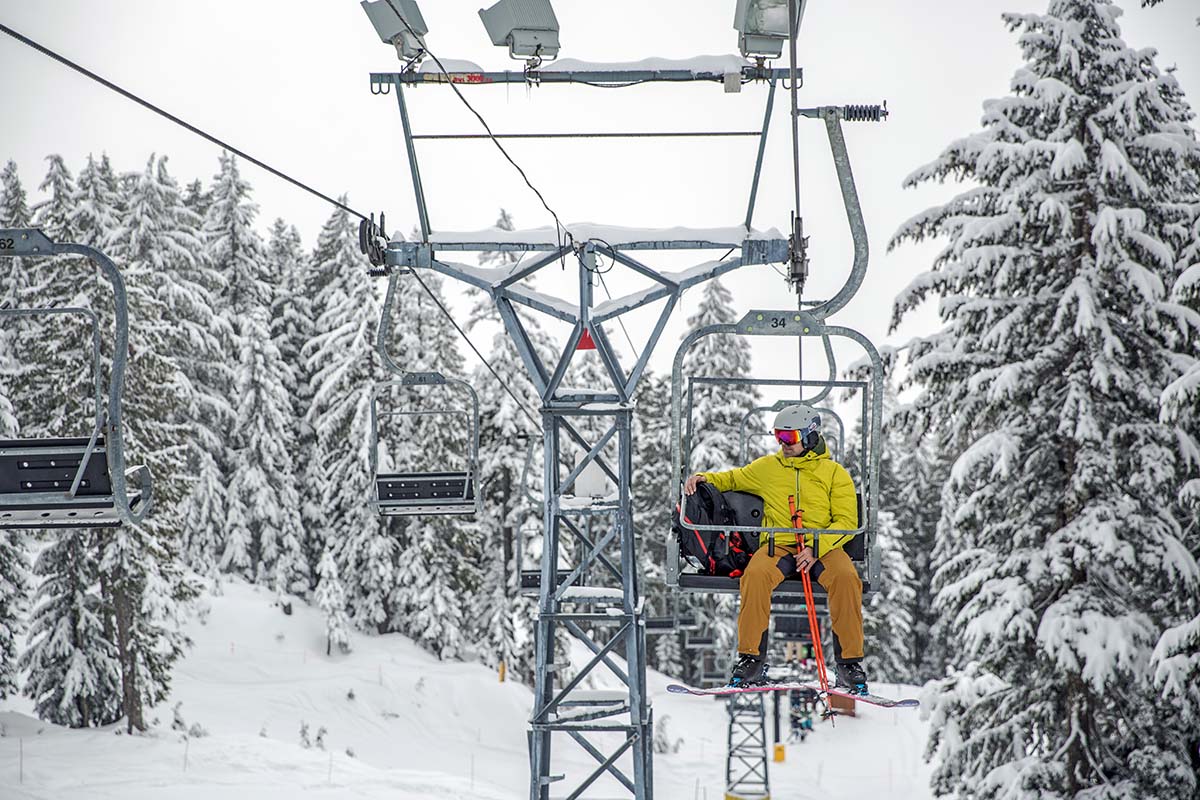
Like much of the outdoor industry, the historical approach to women-specific skis has been to “shrink it and pink it”—in other words, shorten the length, soften the flex, and add a “feminine” colorway. Fortunately, the industry has seen a major shift in recent years, with women-owned and -operated companies like Coalition Snow at the forefront of the innovation—their Rafiki above is our top-rated women's design this year for its effective balance of agility and power. A couple other picks on our list also come in dedicated women's models with unique constructions: the Blizzard Sheeva 11 and Black Crows Anima Birdie.
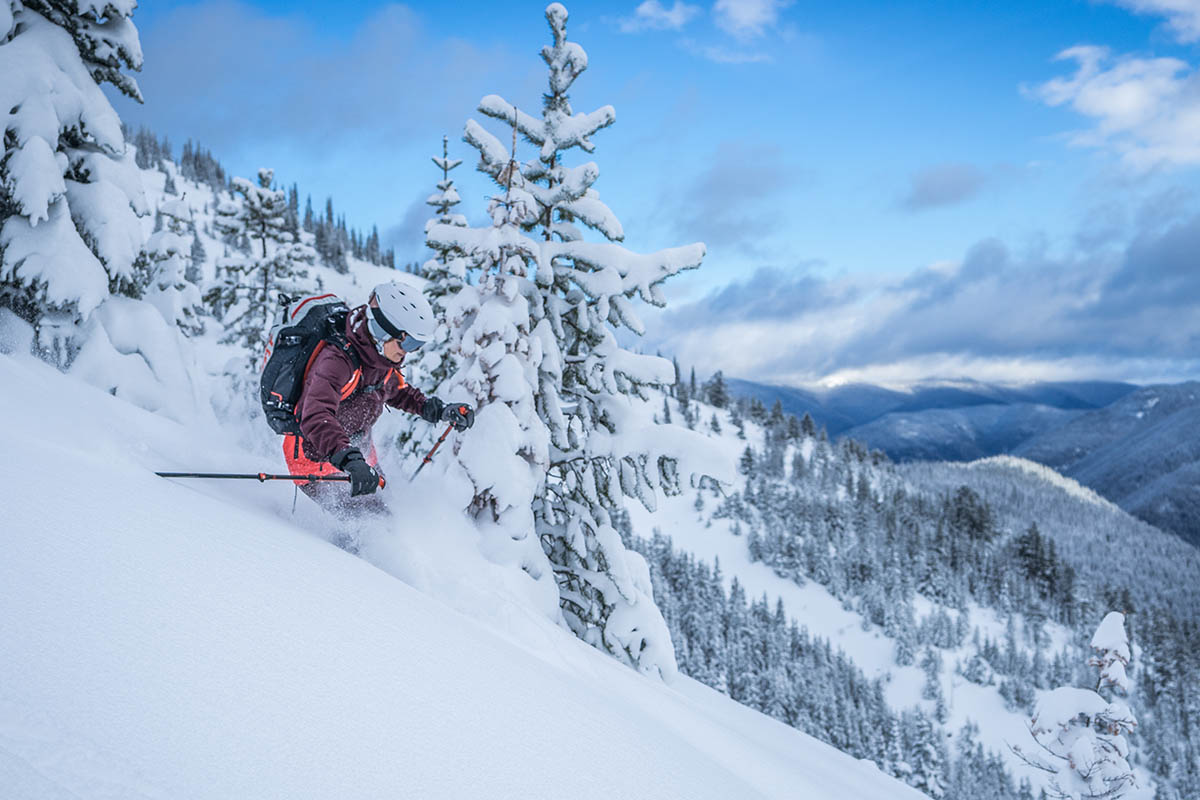
In the end, we urge you to consider all of your options when deciding on which ski is right for you—regardless of the labeling. Take a close look at the quality and characteristics of each model, see what lengths are available (women's models often are made in shorter lengths), and take advantage of demoing skis whenever possible. Some women use unisex skis (note: The primary version of a ski isn't typically a "men's" version but instead unisex by nature), some favor women’s-specific models, and some serious skiers have a quiver that includes both. We recommend getting whichever ski fits and feels best.
Most ski manufacturers provide a size guide on each product page, which often takes your height, weight, and ability level into account to help you decide which length is best for your measurements and riding style. In general, shorter skis are easier to handle and turn faster (they’re well suited for beginner and intermediate riders), while longer skis float better and are more stable at high speeds (at the sacrifice of some maneuverability and ease of control).
It’s also worth factoring in the type(s) of terrain you’ll be skiing most. If your favorite areas have a lot of trees and glades, you may opt for a shorter ski that’s easier to pivot. If you frequent big, open bowls, a longer ski will be more adept at wide, open turns. In other words, a manufacturer’s sizing guide can be a good starting point, but you should also consider your ability level, ski style, and preferred terrain before deciding on the right length for you. We’ve found this sizing chart on Evo to be a helpful baseline with advice on when it’s best to size up or down.
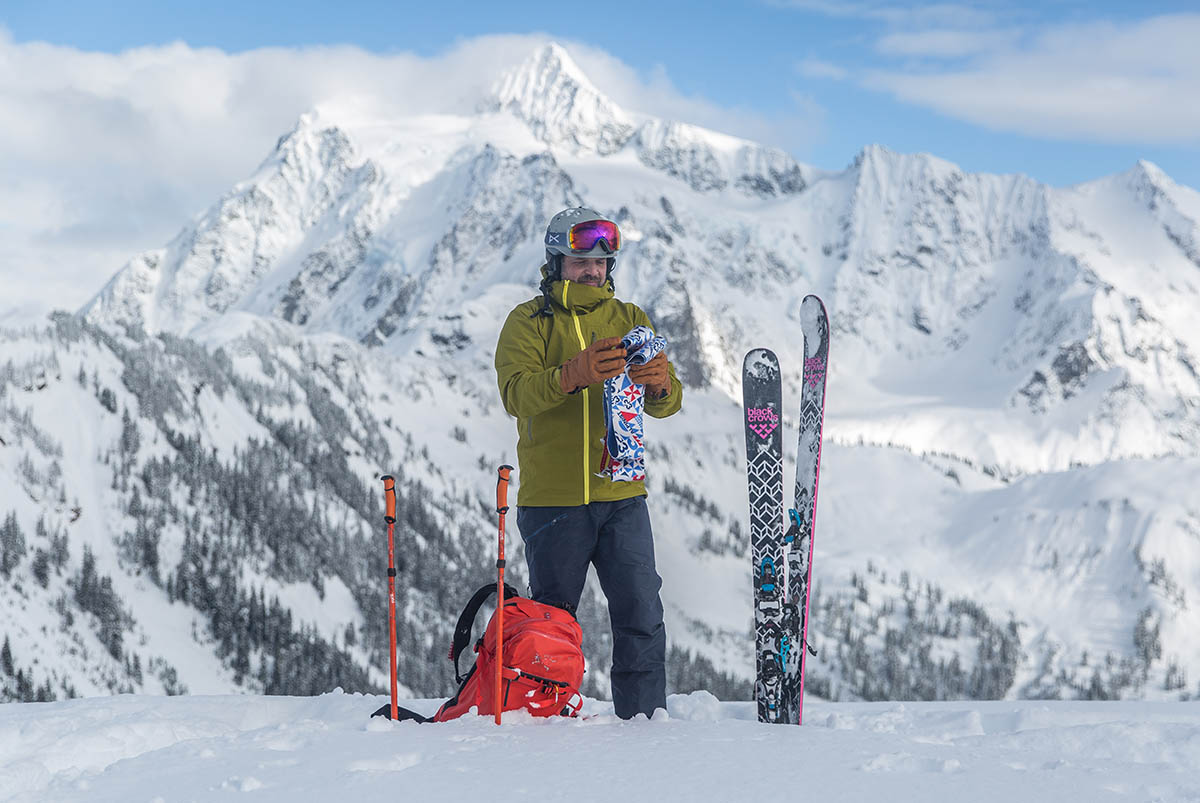
Skis are just one part of your setup, and it’s worth the effort to ensure that all components work together well. In short, skimping or not matching the stiffness or ability level on one piece (skis, boots, or bindings) will impact the performance of everything else. For example, if you opt for a boot that’s too soft for your rigid, high-performance skis, you may struggle to transfer power and lose some control. On the other hand, if you have entry-level skis and stiff, performance-oriented boots, you won’t be maximizing your boots’ potential.
To help you find the best match, we've broken our recommendations into specific categories: For resort use, check out our ski binding and downhill boot round-ups. And for touring, our backcountry ski binding and touring boot recommendations break down the categories in a similar fashion as powder skis: tailoring the picks to ski conditions and ability level.
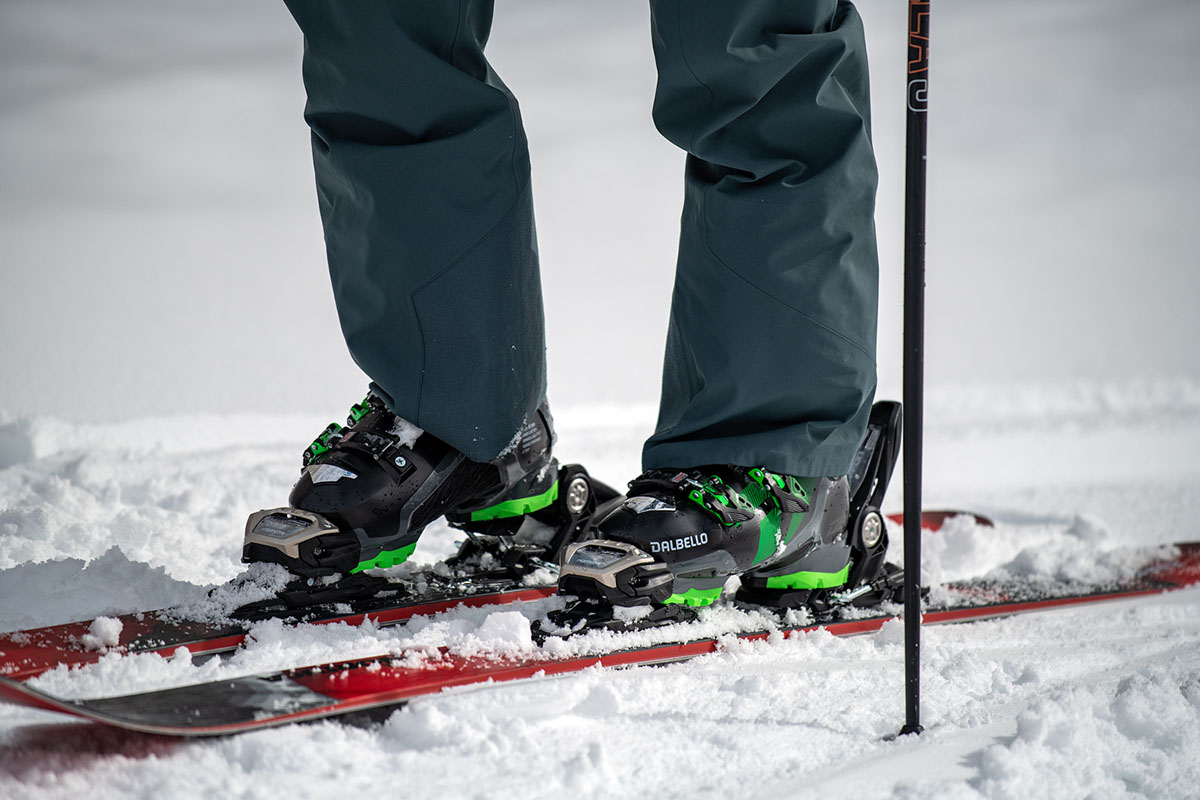
It goes without saying that purchasing a pair of skis is a significant investment and one that requires a good deal of research. Ideally you’ll have a chance to get your hands on the skis before taking the plunge, but that isn’t a reality for everyone and ordering them online is a pretty seamless process these days. Most major retailers offer free and surprisingly fast shipping, which makes it a very attractive option.
Once you get your skis, you’ll need to get your bindings mounted. Just about any ski shop will do the work for you, with the average cost ranging from about $40 to $70. Many of REI’s 180+ stores also have a ski shop with good discounts on mounting services. Prices vary by store, but the rate at the flagship in Seattle last season was $60 for an alpine mounting. Importantly, members get 20% off shop services, and you’ll also receive a discount if you purchase the skis, boots, or bindings from REI. Evo and Backcountry also offer mounting services at their stores, although they’re few and far between compared to REI.
Back to Our Top Powder Ski Picks Back to Our Powder Ski Comparison Table